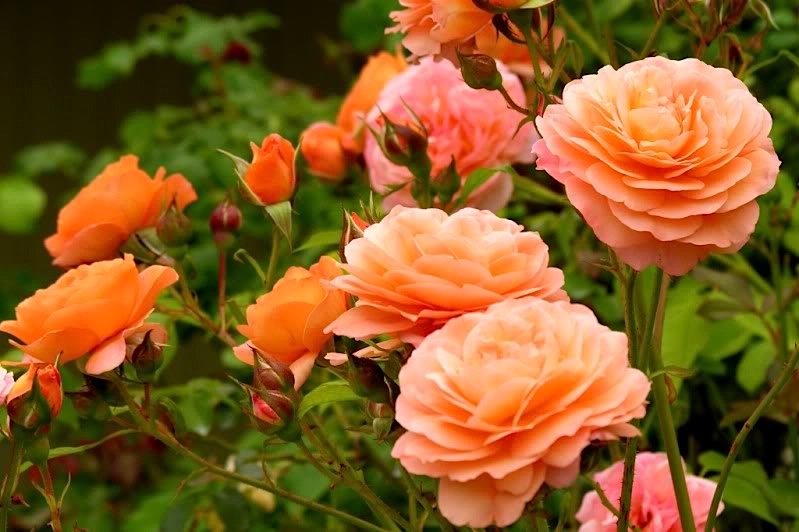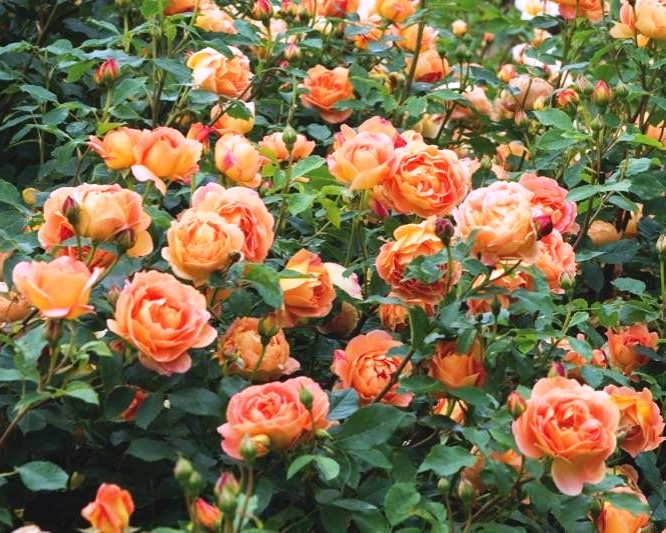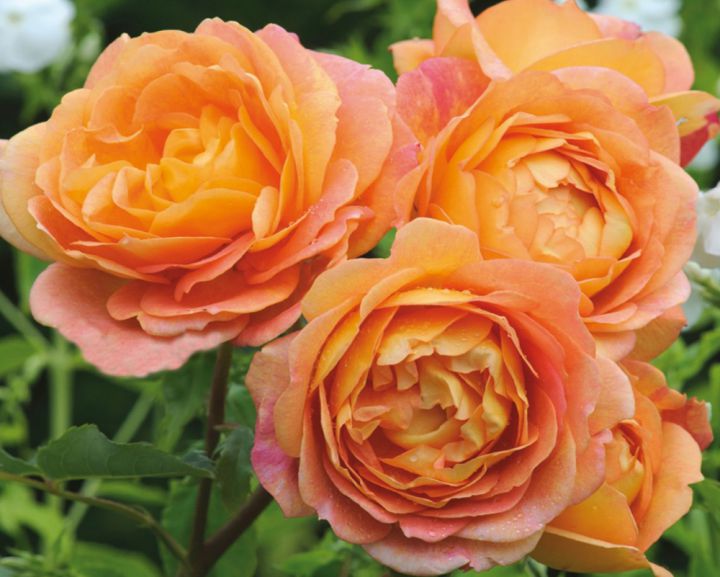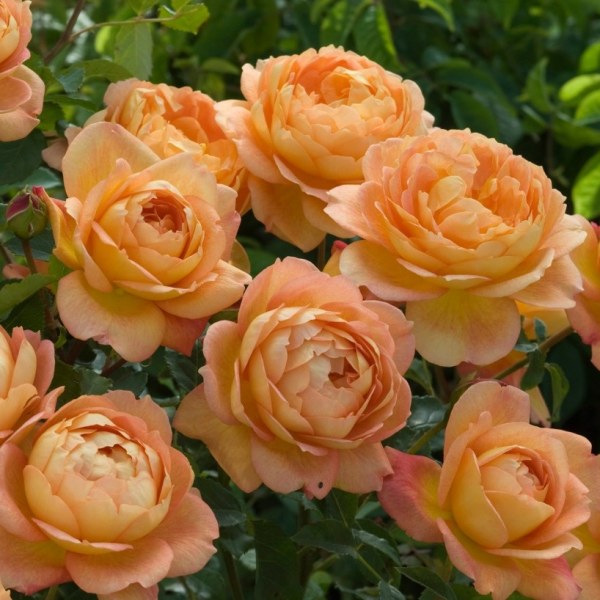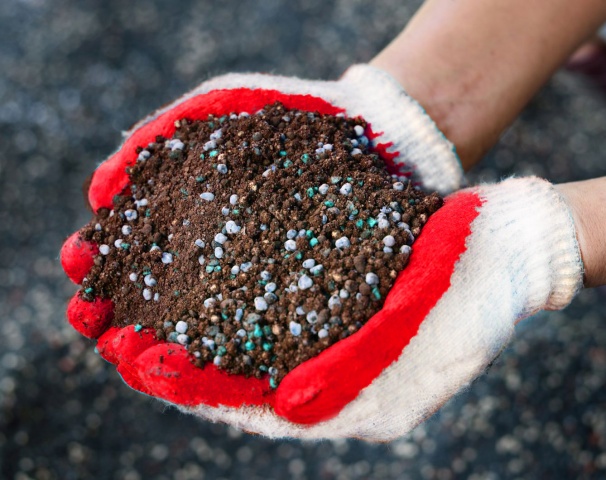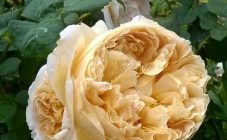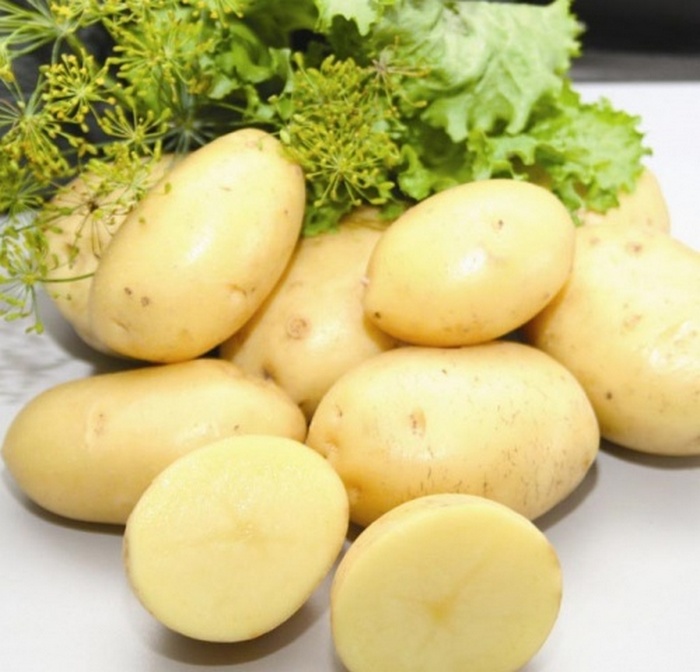Content:
Rose Lady of Shallot appeared relatively recently, but has already managed to gain popularity among European and Russian gardeners. In 2009, an English breeder David Austin created a new flower culture. This variety was named in honor of the heroine of the poem ("The Sorceress of Shallot") by the British poet Tennyson. It is known in the catalog as Ausnyson. In 2011, Lady of Shalott rose for its high quality received an award - a certificate of the Royal National Rose Society.
Description
Lady Shalotte is a rose from the group of English spray roses (shrubs). The bush is powerful, fast-growing, leafy, lush. Its height (100 - 150 cm.), Diameter (80 - 1 m.). The branches are thin, graceful.
Leaves are dark green, glossy, dense, arranged in turns, opposite, densely. Young leaves have bronze shades. There are small thorns. Oval buds with slightly pointed tops. The flowers are quite large (diameter 8-10 cm), densely double, cupped, their shapes resemble peonies. They are painted in salmon, orange-yellow, apricot, pink colors. Each copy has more than 40 petals. Collected flowers in inflorescences (3 - 7 pieces). They open one bud, have a light, fragrant aroma of apples, carnations, tea roses.
Characteristic
Lady of Shalott The Lady of Shalott rose has a repetitive flowering type. Blooms in late spring - early summer. Blooms profusely, for a long time, almost continuously until frost. The plant is characterized by good frost resistance (withstands temperatures of -28 degrees).
The culture tolerates heavy rains well, flowers retain their shape, petals do not crumble. True, freckle specks may appear on the outer petals. But this does not spoil the flowers at all, but gives them even more charm. In cool weather, flowers last longer, open more slowly. From hot sunlight they fade slightly, acquire creamy tones, but the petals do not melt.
The plant is highly resistant to black spot, powdery mildew. It is possible to grow the shallot rose in the open field, as well as as a pot culture. For the latter option, you will need a container with a volume of at least 60 liters. The plant is cultivated mainly in the form of a bush, but the rose also looks great on the trunk.
Growing conditions
To plant a Lady of Shalot rose, you need to choose a sunny, well-protected from winds, drafts place (light partial shade is acceptable). It should be lit in the morning for at least 6 hours. The eastern side of the site is best suited. There, bright sun rays are in the morning, and the rest of the day the plant will be in partial shade.
Plants are planted at a distance of 1 - 1.5 m to the rest of the shrubs, and from tall, large trees (2 - 2.5 m).Rose Shallot prefers fertile, humus-rich, loose, breathable loam. The acidity level is pH 5.6 - 6.5. If heavy, clayey soils, add sand, compost, humus to them. Manure and peat are introduced for acidification. Ash and lime are used to reduce acid.
Preparing for landing
Roses are planted in spring (April - May). This period is suitable for the middle lane, northern regions. In this case, the land is prepared in the fall. They dig up a flower bed, add organic substances. For autumn (September - early October), spring planting, a pit is dug in advance (7-14 days). If the procedure is carried out in the fall, there should be 1 - 1.5 months before the arrival of the first frost, so that the seedling has time to take root.
If the bush was in a container, it is transplanted together with an earthen lump, the grafting point is deepened into the ground (by 6 - 7 cm). In a plant with an open root system, you need to soak the roots. They are immersed for 24 hours in a stimulating solution (Heteroauxin, Kornevin). Too long, damaged roots are trimmed to the beginning of healthy wood. Powder the sections with crushed coal.
Landing
Digging a hole. Its size (40 × 40 cm), depth (30 - 50 cm). The roots of the bush should fit freely. At the bottom of the hole, drainage is poured to choose from: small stone, crushed stone, gravel (10 cm layer). Then organic matter is introduced: compost or rotted manure (15 cm thick). Superphosphate and ash are added. Garden soil is poured on top of everything. Pour half a bucket of water.
Place the seedling in the middle of the hole, gently straighten the roots. Sprinkled with earth, compacted, watered under the roots, sprinkled with dry soil. The near-trunk zone is mulched with peat.
Care
Taking care of Lady of Shallot's bush roses is easy. Young seedlings or newly transplanted plants must be watered abundantly (1 time / 7 days, use 15-20 liters of water for each bush). In hot, dry weather, twice a week. Adult bushes are watered every 10 days. Be sure to carry out spraying, sprinkling.
In the first year after planting, the rose does not need feeding. The next season, in the spring (April - May), they begin to apply nitrogen fertilizers. You can take liquid mullein, chicken droppings. During budding, flowering, as well as in autumn, roses are fed with potassium-phosphorus substances.
During the growing season, weeds are systematically pulled out, the soil is loosened after irrigation, the trunks are mulched with peat. Establish supports for the rose. In the spring, in the fall, you need to cut the bushes. In the spring, the procedure begins at the time of swelling of the kidneys. The initial pruning is done shortly, keeping 2 to 4 buds. It is used after the plants have been planted, as well as for the rejuvenation of old specimens.
In the following years, the main branches are shortened by 1/3, adult bushes are cut off, leaving 5 - 7 buds. This will provoke early flowering, increase decorativeness. Also, all sick, damaged, weak, dry branches are removed annually. Sanitary pruning is carried out in autumn. In the summer, wilted inflorescences are removed.
Preparing for winter
In the middle lane, as well as in cold regions, it is necessary to cover roses for the winter. In the fall, watering is reduced, the last dressing is applied (September). When the first frosts come (-7 degrees), the stems are cut, all remaining shoots, leaves, and inflorescences are removed. Clears the space under the bushes.They burn plant waste. Plants are sprinkled with earth, dry compost, humus.
Spruce branches are laid out between the bushes, as well as on top of them. Supports-arcs or wooden, metal frames are installed above the plants. They should be 20-30 cm higher than the bushes. Cover the structure with a covering material, fix a plastic wrap on top. Leave the side vents.
In the spring (March - April), the ends are opened for airing. The film is removed at the end of April. The nonwoven is not yet removed to allow the roses to get used to the sun's rays.
Reproduction
All Austin roses are propagated vegetatively.
- By cuttings. In the summer, cuttings are cut after flowering. Each petiole must have at least 3 buds. Lower sections are made at an angle below the kidney. Buried in moist soil. A month and a half later they are transplanted;
- Layers. The whole process is carried out in late spring - early summer. Choose a healthy annual shoot. The bark is slightly cut off at the location of the kidneys. They are bent to the ground, added dropwise, fixed, periodically watered. The next spring, they are planted in the desired place;
- By dividing the bush. In early spring, a bush is dug up. Divide it into 2 - 3 parts. They are seated. In the first year, the buds are removed so that the rose grows greenery.
Advantages and disadvantages of the variety in comparison with other varieties.
The advantages, of course, can be called - the most beautiful appearance of flowers, their aroma, not too whimsical care. The disadvantages of many growers include the somewhat high price of cuttings.
The Lady of Shallot rose can be grown as a single bush, as well as in group compositions, pots. It will decorate any square, garden, summer cottage, even a room, it can be used for cutting.
